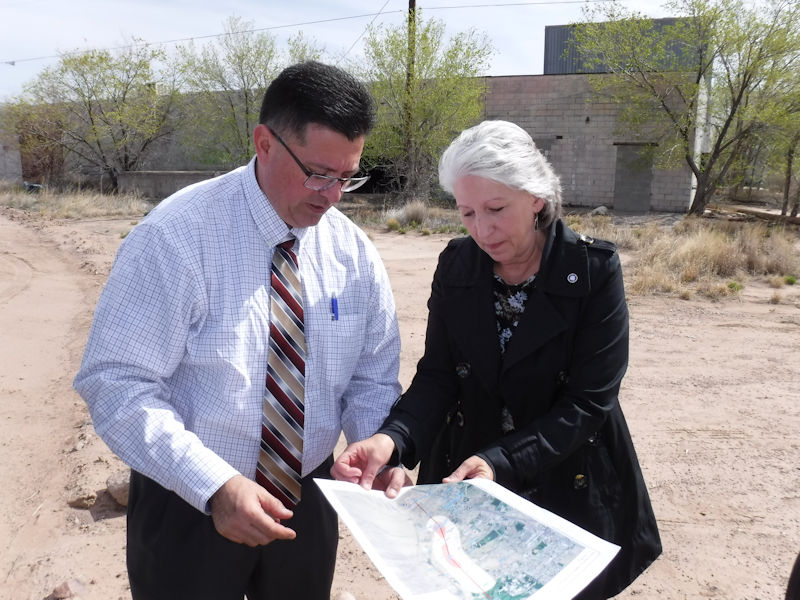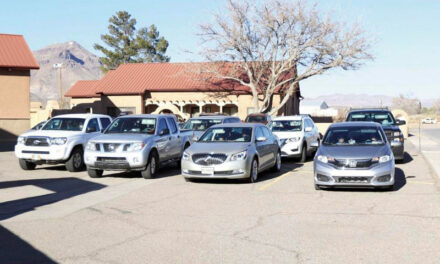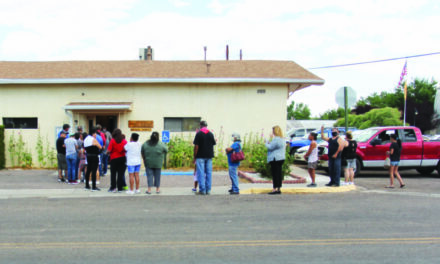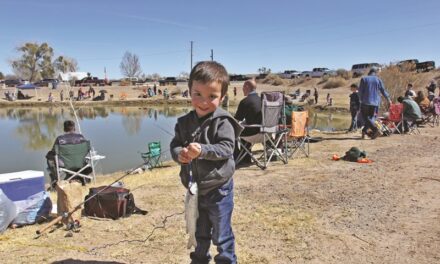
Former 28th District Senator Gabe Ramos discusses a map of the toxic plume with Cheri Lerew at the Eagle Picher site in 2019.
John Larson | El Defensor Chieftain
The underground plume of toxic chemicals equivalent in size to 240 football fields has slowly migrated southward to residential areas of Socorro from the site of the former facility now known as the Eagle Picher Carefree Battery Superfund Site. Reports of these contaminants leaking into the groundwater in the northern part of the city have concerned both city and county officials, and residents in that part of town for almost two decades.
That worry has been alleviated, in part, thanks to an announcement last Friday by the U.S. Environmental Protection Agency, which has been given the all-clear to use a $1 billion investment from the Bipartisan Infrastructure Law to clean up and clear the backlog of 49 previously unfunded Superfund sites and accelerate cleanup at dozens of other sites across the country.
The Socorro Eagle Picher Carefree Battery site in Socorro was specifically named in the press release as a high priority.
“Wow!” was Socorro Mayor Ravi Bhasker’s reaction to Friday’s announcement.
“We are very pleased in the investment by President Biden and the bipartisan group to help clean up our Superfund site at Eagle Pitcher,” Bhasker was quoted in the press release. “This will make a significant difference in our quality of life and future viability of our small city.”
The announcement also comes as good news for Cheri Lerew, who has been vocal about the slow response by the EPA. Her home is located directly over the underground plume of 1,4 Dioxane, TCE and PCE extending over 9,000 feet in length, from just south of the Eagle Picher site to the northern part of the New Mexico Tech golf course.
Besides the groundwater contamination, another danger comes from harmful gases rising from the plume, seeping up through the soil and water table. While the New Mexico Environmental Department regulates the water, the EPA analyzes where those gases might be coming into homes.
While welcoming the funding announcement, Lerew is still cautious about celebrating.
“It’s great news if we can get over the funding hurdle, but I have to wonder whether they will start cleaning up the site before the funding runs out,” she said. “As far as I know, they haven’t yet come up with a final plan on how to do that. The last information I had was that they had data gaps due to a lack of knowledge of how deep the plume is. I would hope that some people in a position to apply pressure would do that.”
Lerew bought her house in 2007, the same year Eagle Picher was declared a Superfund site—and decades after the groundwater pollution was first discovered.
“Approximately 60 percent of the sites to receive funding for new cleanup projects are in historically underserved communities,” EPA Administrator Michael S. Regan said in the press release. “Communities living near many of the most serious uncontrolled or abandoned releases of contamination will finally get the protections they deserve.”
The cleanup design is commonly known as pump and treat.
According to the EPA, chemical oxidation is “an in situ remediation technology that can be applied to groundwater or soils and many different contaminants.” In other words, a chemical technology where strong oxidants are injected or mechanically mixed into the treatment zone to promote destructive abiotic degradation reactions.
As outlined in a previous Chieftain article, the Eagle Picher plume will be remediated in phases:
- Evacuate soil from the Eagle Picher site and dispose of it off-site.
- Remove construction debris containing asbestos-containing building material and lead-based paint.
- Implementing a Phased Pump and Treat remedy to restore groundwater.
- Active containment of vapor intrusion for homes to actively remove soil gas before it migrates indoors.
The phased project is expected to take up to 30 years at a cost of $16 million.
The other New Mexico superfund site tagged for cleanup is the McGaffey and Main site in Roswell, which housed former dry-cleaning operations which contaminated groundwater with perchloroethylene. Remedial action activities for the source area soil and soil vapor are ongoing at the site.
“Cleaning up these sites is long overdue,” Sen. Martin Heinrich said. “That’s why I’m proud to welcome this federal funding support from the EPA to assist the ongoing cleanup efforts at these two contaminated sites in Socorro and Roswell.”
The $1 billion investment is the first wave of funding from the $3.5 billion in the Bipartisan Infrastructure Law to help clean up polluted Superfund sites in communities, making it one of the largest investments in American history to address the legacy pollution that harms the public health of communities and neighborhoods.
“Addressing the environmental and public health tolls these contaminated sites have on our communities has been long overdue.” Sen. Ben Ray Luján said. “I’m proud to have supported the provisions of the Bipartisan Infrastructure Law that empower the EPA’s Superfund program to clean up contaminated sites in Socorro and Roswell.”
The EPA says it is committed to carrying out this work in line with President Biden’s Justice40 Initiative by advancing environmental justice and incorporating equity considerations into all aspects of the Superfund cleanup process.
“This will help ensure that historic and ongoing impacts of contamination on overburdened communities are fully considered and addressed,” officials say.
For the present time, the Community Advisory Group will continue meeting on the second Thursday of each month. Rebe Feraldi, who chairs the group, feels the voice of the public is as important as ever to facilitate getting information from the EPA and then from the community back to the EPA.
“They still need information from the public,” she said. “We urge residents to voice their concerns either in person or on Zoom. They can also attend telephonically.”
More information and links can be found on the group’s Facebook page, Socorro NM Eagle Picher Superfund site.
The advisory group meetings are held on the second Thursday of every month from 6:30-8 p.m. at the Socorro Public Library and are hosted virtually by the EPA’s Jason McKinney, Senior Public Affairs Specialist.


















